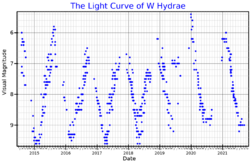Astronomy:W Hydrae
| Observation data Equinox J2000.0]] (ICRS) | |
|---|---|
| Constellation | Hydra |
| Right ascension | 13h 49m 01.998s |
| Declination | −28° 22′ 03.49″ |
| Apparent magnitude (V) | 7.7 - 11.6[2] |
| Characteristics | |
| Spectral type | M7.5e-M9ep[3] |
| Apparent magnitude (J) | -1.7[4] |
| Variable type | Mira |
| Astrometry | |
| Parallax (π) | 10.18 ± 2.36[5] mas |
| Distance | 98[6] pc |
| Details | |
| Radius | 229[7]–560[8] R☉ |
| Luminosity | 7,330[6] L☉ |
| Temperature | 2,500[9] - 3,129[7] K |
| Other designations | |
| Database references | |
| SIMBAD | data |
W Hydrae is a Mira-type variable star in the constellation Hydra. The star is nearly located within the Solar neighborhood, between 75 and 120 parsecs, likely at 320 light years from the Sun. It has a visual apparent magnitude range of 5.6 to 10. In the near-infrared J band it has a magnitude of -1.7,[4] is the 7th brightest star in the night sky, and is even brighter than Sirius.
Water and dust masers
The star also shows signs of intense water emissions, indicative of the presence of a wide disk of dust and water vapour.[9] Such emissions cover a zone spanning between 10.7 Astronomical Units (within Saturn's orbital zone) and 1.2 parsecs (or nearly 247,500 Astronomical Units, as far away as the Oort Cloud in Solar System).
References
- ↑ "Download Data". AAVSO. https://www.aavso.org/data-download.
- ↑ "GCVS Query=W Hya". General Catalogue of Variable Stars @ Sternberg Astronomical Institute, Moscow, Russia. http://www.sai.msu.su/gcvs/cgi-bin/search.cgi?search=W+Hya.
- ↑ Samus, N. N. et al. (2009). "VizieR Online Data Catalog: General Catalogue of Variable Stars (Samus+ 2007-2013)". VizieR On-line Data Catalog: B/GCVS. Originally Published in: 2009yCat....102025S 1. Bibcode: 2009yCat....102025S.
- ↑ 4.0 4.1 "V* W Hya". SIMBAD Astronomical Database. http://simbad.u-strasbg.fr/simbad/sim-id?Ident=V*+W+Hya.
- ↑ Vlemmings, W. H. T.; Van Langevelde, H. J.; Diamond, P. J.; Habing, H. J.; Schilizzi, R. T. (2003). "VLBI astrometry of circumstellar OH masers: Proper motions and parallaxes of four AGB stars". Astronomy & Astrophysics 407: 213–224. doi:10.1051/0004-6361:20030766. Bibcode: 2003A&A...407..213V.
- ↑ 6.0 6.1 McDonald, I.; De Beck, E.; Zijlstra, A. A.; Lagadec, E. (2018). "Pulsation-triggered dust production by asymptotic giant branch stars". Monthly Notices of the Royal Astronomical Society 481 (4): 4984. doi:10.1093/mnras/sty2607. Bibcode: 2018MNRAS.481.4984M.
- ↑ 7.0 7.1 De Beck, E.; Decin, L.; De Koter, A.; Justtanont, K.; Verhoelst, T.; Kemper, F.; Menten, K. M. (2010). "Probing the mass-loss history of AGB and red supergiant stars from CO rotational line profiles. II. CO line survey of evolved stars: derivation of mass-loss rate formulae". Astronomy and Astrophysics 523: A18. doi:10.1051/0004-6361/200913771. A18. Bibcode: 2010A&A...523A..18D.
- ↑ Zubko, Viktor; Li, Di; Lim, Tanya; Feuchtgruber, Helmut; Harwit, Martin (2004). "Observations of Water Vapor Outflow from NML Cygnus". The Astrophysical Journal 610 (1): 427–435. doi:10.1086/421700. Bibcode: 2004ApJ...610..427Z.
- ↑ 9.0 9.1 Zubko; Elitzur, Moshe (2000). "Water and Dust Emission from W Hydrae". The Astrophysical Journal 544 (2): 137–140. doi:10.1086/317317. Bibcode: 2000ApJ...544L.137Z.
Coordinates: ![]() 13h 49m 01.998s, −28° 22′ 03.49″
13h 49m 01.998s, −28° 22′ 03.49″
External links
- AAVSO Variable Star of the Month. April 2008: W Hya
- W Hya[yes|permanent dead link|dead link}}] at AAVSO (chart #8585EPX)
 |


